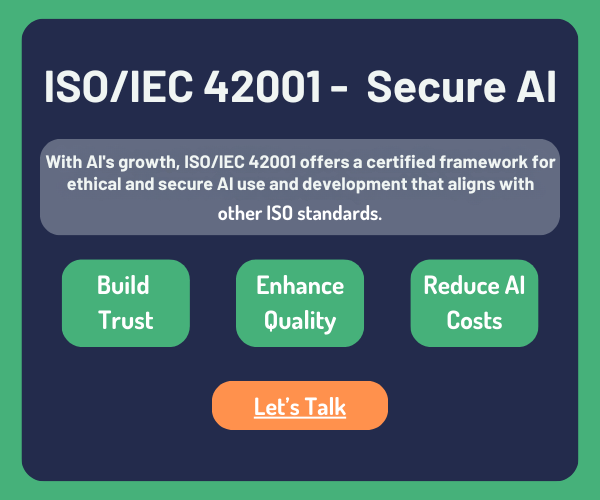In this article
How to Build an ISO 42001 Training Program That Works
- Sajjad Syed

ISO 42001 isn’t just about checklists—it’s about building organizational capability. Your policies are only as strong as the people applying them. Whether you’re developing models, managing third-party AI tools, or guiding risk decisions, ISO 42001 requires your team to understand risk, regulation, and responsible governance.
This article explores how to prepare your organization for ISO 42001 certification with targeted, scalable training programs—tailored to role, maturity level, and business objectives.
Why Training Matters in ISO 42001
ISO 42001 places strong emphasis on organizational competence. Policies alone don’t build compliance—people do. Without proper training:
- Risk assessments may be inaccurate
- Human oversight controls could fail
- Teams may unknowingly violate privacy laws
- Documentation and audit trails could become inconsistent
To succeed in audits and sustain long-term accountability, AI governance must be part of your organization’s DNA.
Key Roles That Need Training
Role | Primary Responsibilities |
AI/ML Engineers | Model development, testing, fairness validation |
Product Managers | Use case scoping, risk flagging, compliance coordination |
Compliance Officers | Policy enforcement, audits, vendor due diligence |
Legal & Privacy Teams | Data rights, contracts, regulatory alignment |
IT & Security Teams | Logging, monitoring, access controls |
Executives | Oversight, investment, certification alignment |
Each of these groups touches different parts of the AIMS lifecycle—and requires tailored education.
Step 1: Define AI Use Cases and Boundaries
Map all AI systems across your organization:
- What is the system’s function and scope?
- Who is affected by its outputs?
- What data, models, and vendors are involved?
This scoping step anchors your risk evaluation and ensures accurate mapping to Annex A controls.
Step 2: Assess Impact Across Risk Categories
Use a risk matrix to evaluate likelihood and impact:
- User harm (bias, discrimination, misinformation)
- Legal exposure (fines, lawsuits, compliance failure)
- Operational failure (downtime, model error)
- Reputation loss (loss of trust, brand damage)
Assign owners, document risks, and quantify the potential consequences.
Step 3: Apply Mitigation Using ISO 42001 Controls
Map identified risks to Annex A controls. Examples:
Risk | Control | Strategy |
Gender bias in recruitment AI | A.7.2 Fairness | Retrain with balanced data, validate outcome equity |
Poor explainability in loan AI | A.6.1 Oversight, A.7.3 Explainability | Introduce interpretable models + override policies |
Privacy gaps in chatbots | A.7.4 Data Security, A.5.4 Risk Controls | Anonymize inputs, monitor for data leakage |
🛠 Tip: Assign ownership. Record how each control will be implemented, validated, and maintained.
Step 4: Document the Risk Assessment
ISO 42001 requires audit-ready documentation, including:
- A formal risk register
- Justification for each applied (or excluded) control
- Evaluation of residual risk
- Links to evidence (e.g., logs, validation reports, policies)
This becomes the backbone of your AI audit and certification package.
Step 5: Review & Update Continuously
AI risk is dynamic. ISO 42001 encourages ongoing reassessment:
- New system deployments
- Model retraining or data changes
- Changes in law or industry regulation
Embed reviews into your AIMS lifecycle and schedule quarterly or semiannual assessments (NIST, 2023).
In today’s world, cybersecurity and Infosec (Information Security) are crucial. ISO 27001 helps organizations minimize the risk of data breaches, comply with regulations, and build trust with customers. The standard focuses on both preventing risks and improving your systems over time.
Training Topics by Department
Department | Core Training Topics |
Engineering | Bias mitigation, explainability, secure ML, Annex A controls |
Product/UX | Ethical impact mapping, use case classification, user transparency |
Legal/Compliance | EU AI Act, U.S. EO, SoA documentation, control justifications |
Data Teams | Data lineage, PII anonymization, consent tracking |
Security/IT | System logging, AI threat modeling, access control |
Executives | Governance roles, audit cycle, ROI of responsible AI |
📌 Pro Tip: Use role-based scenarios and case studies. Real-world failures and audit red flags drive the message home.
Building a Scalable Training Program for Compliance
To meet ISO 42001 standards, your training must be:
- Documented – Attendance logs, material archives, testing results
- Repeatable – Run training for new hires or after policy updates
- Role-Based – Match content to employee responsibilities
- Updated Regularly – Reflect evolving risks and regulations
- Auditable – Include assessments or scoring for knowledge transfer
You can automate delivery and tracking with a Learning Management System (LMS) or integrate into your GRC suite (UNESCO, 2023)
Ongoing Education After Certification
One of the most overlooked elements of ISO 42001 is continuous education. AI systems evolve. So must your people.
✅ Best Practices:
- Quarterly refreshers or risk workshops
- Responsible AI onboarding for new hires
- Internal knowledge hub or intranet for AI governance
- Monthly or quarterly lunch & learns with guest speakers
Why Work With Consilium Labs
At Consilium Labs, we blend ISO 42001 rigor with real-world delivery. Our training frameworks are:
- Role-based and audit-aligned
- Tailored for SaaS, healthtech, and compliance-heavy teams
- Fully documented for LMS or GRC use
We help your workforce move from awareness to accountability.
Final Thoughts
ISO 42001 is more than a framework—it’s a culture. That culture starts with people who are trained to lead with trust, clarity, and oversight.
📩 Need help designing your AI compliance training? Let’s build a program that empowers your team to drive responsible innovation.
Related Articles
Let's get in touch
Start your audit now. Achieving cybersecurity audit can be complex. We have made it our mission to simplify the process, giving you access to the professional expertise you need to prepare your company for the future. Get in touch with us today!





